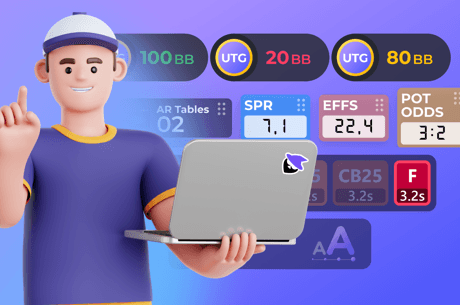Taking Heat With Pocket Aces in a Hand of 100NL 6-Max Zoom

There will be times in no-limit hold'em when you realize that, by dint of circumstances possibly outside of your control, it is hard for you to have the nuts. Yet your opponent could be bluffing.
How, then, do you decide when to call with a bluff-catcher? It depends, of course.
Flop Pressure While Holding an Overpair
It all started so well for small blind in this hand. In a game of 100NL six-handed Zoom ($0.50/$1), he was sitting pretty, having built a stack of $370, and had just been dealt A♦A♣ in the small blind.
He watched the cutoff open to $2.25 from a stack of $230, and when it folded to him he three-bet to $10. The cutoff called, and the two of them saw a flop come Q♦9♥6♦.
The small blind has an interesting flop decision here, to bet or to check. Were the board slightly more coordinated — say, with two diamonds and the A♦ in hand — one would feel this an ideal combination to check-call.
But the three community cards aren't exactly coordinated, with two gaps of two ranks apiece. A lot of value could be left on the table from hands like KQ and QJ-suited should the small blind start checking now.
Thus the small blind went ahead and bet $7 into a pot slightly over $20. The player in the cutoff then raised to $22.
It is hard to see how A♦A♣ could be beat here. The only thing to fear is from a flopped set. So we can agree the small blind must continue. But if he three-bets the flop he will either fold to a four-bet or continue against a four-bet — both bad options. Or his three-bet will be called, another potentially bad outcome!
In lieu of not turning his hand into a bluff, then, he just called the flop raise. Perfectly reasonable.
No Escape
The turn was the 2♣, the biggest blank in the deck. The small blind checked, his opponent bet $47.50, and the small blind called, making the pot $159 — just a little more than the effective stacks. The river then brought the 7♠, making the final board Q♦9♥6♦2♣7♠.
The small blind had to feel comfortable about this runout and checked. The cutoff player shoved and the small blind called.
That's when the player holding aces got bad news. After attacking small blind's flop bet size, the cutoff had hit on a double-gutter with 10♥8♥ to river a straight and win the pot.
Could the small blind have gotten away from this one?
To answer that, we have to balance the implausibility of value hands like 66, 99, QQ, Q9-suited, T8-suited, and 85-suited with the implausibility of river bluff-shoves.
Listing potential river bluffs in this spot is not easy since 10♥8♥, for example, could be played as a flop call rather than a raise. The fact that the cutoff was drawing to the nuts on six cards, plus a backdoor heart draw, could give us a hint that he'd play nut draws this way — i.e., hands like K♥J♥ or 8♠7♠ or A♦2♦.
Meanwhile maybe the cutoff would just take the good flop price with weaker draws, i.e., hands like J♣10♣ and K♣J♣. From the showdown we saw, we can't be sure.
But what we can conclude in this spot, actually, is that the three combinations of aces without the diamond — A♠A♥, A♠A♣, and A♣A♥ — are significantly better to call down with than with A♠A♦, A♥A♦, or the combination our poor(er) small blind had here, A♦A♣.
Finding Some Calls
How much better these combinations are is hard to say with incomplete information. Does the cutoff player raise all his flush draws on this flop facing that small bet size or just the nut-flush draw?
Smaller flush draws that take this line will potentially have too much fold equity when they hit their flush, folding out hands they beat, but will get caught when they miss. They'll also sometimes get caught when they hit, by the nut-flush. So it might be advisable to call these on the flop as they perform well against wider ranges. The nut-flush draw can raise and take on strong ranges.
In any case, absent a strong read on villain's bluffing tendencies, it seems impossible for the small blind to have gotten away from pocket aces here that don't include the A♦. But as he did in fact hold the blocker to the nut-flush, he could remove a significant chunk of possible bluffs from his opponent's range.
In a spot like this, consulting one's HUD stat for flop-raise frequency could provide some assistance. But it still wouldn't answer essential questions, such as how often (and with which hands) does the cutoff raise flop in this exact situation in a three-bet pot, facing a smaller bet size, on this exact board texture.
Ultimately, especially in a Zoom player pool where reads and HUD stats may be in shorter supply than normal, you'll find yourself in unfortunately unavoidable spots like the small blind did in this hand, getting stacked. But consulting the suits of your hand when working out your opponent's potential bluffs could save you crucially when the decision gets close.










